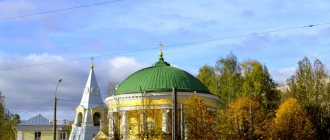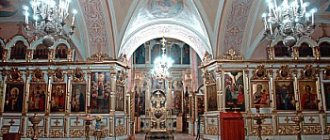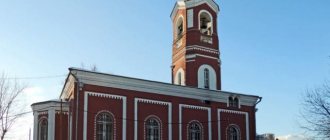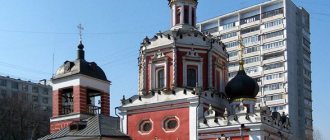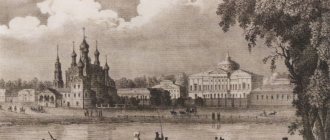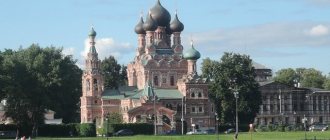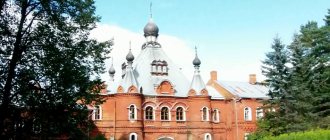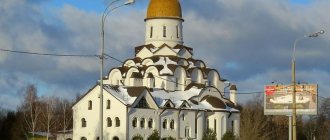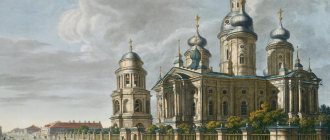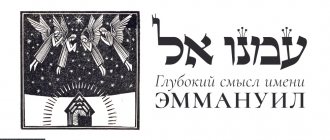The Church of the Life-Giving Trinity on Sparrow Hills belongs to the St. Michael's Deanery of the Moscow Diocese.
Located in the municipal district of Ramenki.
Temple address: Moscow, st. Kosygina, 30.
The Church of the Life-Giving Trinity was built in the style of late classicism
There are three chapels in the temple. The main chapel is in honor of the Holy Trinity, the other two are in honor of St. Nicholas the Wonderworker and St. Sergius of Radonezh.
The history of the temple on Sparrow Hills begins in the 50s of the 15th century
The temple on the Sparrow Hills is associated with the history of the rather ancient village of Vorobyovo. It became known in chronicles from the 50s of the 15th century, when it was bought by the wife of Grand Duke Vasily the First, Sofya Vitovtovna.
Sofya Vitovtovna is a Russian princess, the wife of Prince Vasily I of Moscow. The only daughter of the Grand Duke of Lithuania Vitovt Keistutovich. According to ancient chronicles, it was she who bought the temple on Sparrow Hills
The village of Vorobyovo belonged to the Moscow boyar Yuri Vorobyov, who in 1351 was sent for approval to the Moscow metropolitan see. This village was named after the Vorobyov family.
In the mentions of Yuri Vorobyov himself, he said that when he arrived there, there was already an Orthodox church there. Trinity Church was mentioned only in 1644 as a very ancient church in the village.
But many argue that before this temple, there were 2 - 3 more palace churches in the village. But they were subsequently dismantled, and in their place a single Trinity Church with several chapels was built.
By the end of 1790, the temple had become very dilapidated, and by order of Catherine the Great the temple was dismantled.
Another temple that we see now began to be built in 1811 in the style of late classicism. The architect of the temple was A.L. Vitberg.
Alexander Lavrentievich Vitberg is a Russian artist and architect of Swedish origin, author of the project for the Cathedral of Christ the Savior in Moscow. He was the architect of the temple on Sparrow Hills
The temple was built on a quadrangular plan with portals decorated with columns, and had a single dome. A two-tier bell tower was built nearby.
Mikhail Illarionovich Kutuzov himself prayed in this temple in 1812.
Mikhail Illarionovich Kutuzov is a Russian commander, statesman and diplomat.
In 1812 he prayed in the Church of the Life-Giving Trinity on Sparrow Hills
After the Napoleonic invasion, the temple building survived. Construction of the temple was completed in 1813. The temple was renovated twice - in 1858 and in 1898.
Temple Information
The wooden Trinity Church on the Sparrow Hills has existed since ancient times and is associated with the history of the ancient palace village of Vorobyovo. According to the chronicle, it is known that when in the 15th century the village was bought by Grand Duchess Sofya Vitovtovna, the wife of the Moscow Grand Duke Vasily I and the daughter of the Grand Duke of Lithuania Vitovt, the temple was already standing.
The first priest of the wooden Trinity Church known to us was Fr. Titus, who was abbot from 1628 to 1632. According to the parish books of the Patriarchal Treasury Order of 1628, the Wooden Trinity Church in the village of Vorobyovo was listed among the “residential” Moscow churches - “beyond the Wooden City”. Until 1690, the Trinity Church was built in the Prechistensky Forty of Moscow, and from 1691. it was already written in the Zagorodskaya Tithe. By the end of the 1790s, the temple had become very dilapidated and was dismantled by order of Catherine the Great. The last priest of the wooden Trinity Church was Father Nikifor Vasiliev.
The current brick church with a white stone plinth was built in 1811 according to the design of the architect A.L. Vitberg, the author of the design of the temple-monument of Christ the Savior on Sparrow Hills. The building was built in the style of late classicism, as stated in the documents “... through the diligence of parishioners and willing donors...” The first rector of the stone church was Father Jacob Ilyin. The stone temple was erected near the previous wooden one. In 1811, a crowned one was installed on the site of the altar of the old church. cross is a white stone monument that has survived to this day. The porch in front of the entrance on the western facade of the bell tower and extensions on its sides appeared during renovations of the building in 1858-61 and 1898. The territory of the church is surrounded by a brick fence of the late 19th - early 20th centuries. with metal grille.
In 1812, M.I. Kutuzov prayed here before the council in Fili. The building survived the Napoleonic invasion.
Until 1818, the temple was listed among the churches of the Moscow district, and from March 30, 1818, in the Zamoskvoretsky forty of Moscow.
Trinity Church not only escaped socialist destruction, but was not even closed during Soviet times, so its ancient interior has been preserved. Moreover, after the well-known Bolshevik ban on bell ringing throughout Moscow, it was in the Vorobyov Trinity Church that the bells continued to ring and Orthodox Muscovites secretly went to listen to the blessed ringing of its bells. Once again, the church survived the construction of a high-rise building at Moscow State University in the late 1940s and early 1950s.
Now the temple on the Sparrow Hills has, as before, three chapels - in honor of the Holy Trinity, St. Nicholas the Wonderworker, and St. Sergius of Radonezh. There is also a side altar of St. Jonah, Metropolitan of Moscow, which is located in the altar of St. Nicholas.
The temple belongs to the Mikhailovsky Deanery of Moscow.
Shrines: In the temple there are icons of the 19th century - “Saints Gury, Samon and Aviv”, “Saints Cosmas and Damian”, “The Burning Bush”, “Joy of All Who Sorrow”, the “Kazan” icon of the Mother of God, a four-part icon - with images of the Nativity of Christ , the Nativity of the Blessed Virgin Mary, the Nativity of John the Baptist and the Nativity of St. Nicholas the Wonderworker, the icon of the “Savior Not Made by Hands” from the school of Simon Ushakov. The revered icon of the Mother of God - “Blessed Heaven”. Ancient icons: a revered copy of the miraculous icon of the Mother of God “Donskaya” and holy. Nicholas with his life. In the temple there is a reliquary with particles of the relics of saints: St. Mitrophan of Voronezh, Righteous Alexy (Mechev) and Blessed Matrona of Moscow.
They wanted to close the temple many times, but the Lord preserved it for believers
Like almost all churches, during the Soviet years they tried to close it several times.
For example, at the end of the 20s of the 20th century they wanted to close the temple due to the construction of the Palace of the Soviets, which they wanted to place on the Sparrow Hills.
In 1940, they wanted to build Moscow State University on this site, but none of these plans came true, and the temple was not closed.
In 2000, Vladimir Putin visited the temple very often. In 2004, he attended a litany for those killed during the Beslan terrorist attack. In September 2014, he lit a candle in the church for those who suffered while protecting people in Novorossiya.
In the photo, the still young Vladimir Putin visited the temple on Sparrow Hills, and did this more than once
The temple was also classified as a cultural heritage monument of Federal significance in the city of Moscow.
And also, on the basis of an order from the Moscow City Department, the church building was transferred to the ownership of the Russian Orthodox Church in 2016.
Barkhatov.com
One of the surviving and currently operating Trinity churches is hidden on Sparrow Hills - it is well known to visitors to the observation deck in front of the Main Building of Moscow State University and to passengers crossing the Moscow River on the metro bridge. This church turns white against the background of the dense crowns of the Sparrow Hills, like on a patterned carpet, especially in autumn, and in clear weather its small domes sparkle with gold - and it seems so tiny next to the giant university. More recently, there were proposals to give this temple to Moscow University as a house church - this is how they tried to protect the Moscow State University student theater within the walls of its own house church on Mokhovaya. And no one wondered how so many parishioners could fit within the walls of a small old church at the same celebration of Tatiana’s Day.
The Trinity Church has been connected throughout its life with the history of the ancient palace village of Vorobyovo. Its current building was built at the beginning of the 19th century, but the foundation of this church dates back to very early times in Moscow history. The village of Vorobyovo has been reliably known since 1451 or 1453, when Princess Sofya Vitovtovna, the wife of Moscow Grand Duke Vasily I, bought it from “Priest Sparrow” - it is believed that the name of the village and then the entire area “Sparrow Hills” came from the name of the priest. . Moscow legends interpret this name differently: as if dense cherry orchards grew here and therefore there were many sparrows pecking at the berries. Or simply the outlying mountains of Moscow - not mountains at all, but just hills, so small that they are “mountains” not for people, but for sparrows.
Since Vorobyovo was called a “village” from the very beginning of its appearance in the history of Moscow, this means that in those days there was already an Orthodox church here. It is possible that it was the Trinity Church that stood then in the village of Vorobyovo, which became the summer palace residence of the Moscow sovereign. Ivan the Terrible's father, Grand Duke Vasily III, fell in love with this beautiful place. Back in 1521, during the invasion of Mengli-Girey, he hid here, near the wooden palace he built, in a haystack, and remained unharmed. From Vorobyov, the Grand Duke often went hunting near Volokolamsk, and while hunting in the late autumn of 1533 he became dangerously ill. The cruelly suffering prince was brought to the Vorobyovsky Palace, where he lay for two days, waiting for a bridge to be built to cross him - the ice had not yet firmly bound the river. But when the horses harnessed to the sovereign’s cart stepped onto the erected bridge, it collapsed, and the rider was miraculously not injured. He did not have long to live - the sick prince was transported on a ferry near Dorogomilov and taken to the Kremlin, where he died the next day, December 3, 1533. His son, heir John, was not even 4 years old at the time.
And when Ivan Vasilyevich turned 17 years old, he retired to his father’s shelter during a terrible summer fire in Moscow in 1547. Thus, in the Vorobyovsky Palace, Ivan the Terrible experienced the first terrible days of his reign - only six months passed after his coronation to the Russian throne. The burning city was deserted, and the rebel people rushed here, to the royal palace, but were met with cannons. This event marked the beginning of the reign of the first Russian Tsar.
The Vorobyovsky Royal Palace lived a long life. Boris Godunov, Peter I, who ordered a birch grove to be planted in his garden, and Catherine the Great loved him, but by the end of her reign in the 1790s, the palace was dismantled due to its disrepair. And twenty years later, on the Sparrow Hills, the “crown of Moscow”, according to the figurative expression of Emperor Alexander I, the construction of the Cathedral of Christ the Savior began according to the design of A. Vitberg - their first “great construction”.
Trinity Church, which became one of the local palace churches, witnessed all these events. It was mentioned in 1644 as a very ancient church that had long stood in Vorobyovo. The fact is that along with it there were 2 - 3 more palace churches. One day they were all dismantled and in their place they built one Trinity Church with side altars. But the current church building, built only in 1811, has seen a lot in its lifetime. Already in 1812, M.I. Kutuzov himself prayed in it before going to the military council in Fili. According to legend, this area has been associated with the Kutuzov family since ancient times. The village of Golenishchevo, neighboring Vorobyov, with another, also Trinity Church, in the area of modern Mosfilmovskaya Street, and from the 15th century became part of their old boyar surname - as if the Moscow Metropolitan Jonah healed the boyar Vasily Kutuzov there, and this miracle was depicted in one of the hallmarks local icon of the saint in the Trinity-Golenishchevsky Church. That is why the descendants of the healed boyar began to be called Kutuzov-Golenishchev.
And the Trinity Church in Vorobyovo survived even after Napoleon himself came here to look at the panorama of Moscow, which lay at the foot of the Vorobyovy Mountains. The completion of the construction of the Trinity Church is sometimes attributed to the famous “holy doctor” F. Haas, who took such care of the prisoners of the local transit prison, built from former barracks for construction workers of the Witberg Cathedral of Christ the Savior. He wanted the prisoners to be somehow assigned to this church, to have the opportunity to attend services and be cared for by its priests.
The Trinity Church, remote from the center, miraculously survived during Soviet times - although the Bolsheviks paid attention to the Sparrow Hills (somewhere here was the dacha of Lunacharsky himself, and then Khrushchev) and attached great importance to the urban planning plans of the new, socialist Moscow. It was none other than L.B. who proposed renaming the Sparrow Hills to Lenin Hills. Krasin in February 1924, after Lenin's death. He also gave the idea to erect a giant monument to the leader and build a palace in his name. These plans of Krasin later formed the basis for the idea of the Palace of Soviets, for which, by the way, Vorobyovy Gory was also proposed at one time.
And according to the notorious General Plan for the Socialist Reconstruction of Moscow in 1935, the Lenin Hills were the final, final part of the supposed main main thoroughfare of the new city - Ilyich Avenue, passing through the center of Moscow and the Palace of Soviets. According to the authors of the project, the Lenin Mountains became the main vacation spot for Muscovites. “Imagine a mass holiday in socialist Moscow, when tens of thousands of vacationing proletarians will walk along Ilyich Alley, rejoice on the fields of mass events, and relax on the water. The aerial cableway carries more and more Muscovites over the Moscow River to the green Lenin Mountains, from where a magical panorama of the new Moscow opens, no longer without the shiny copper dome b. Church of the Savior, but with a towering silhouette of metal, concrete and glass - the majestic building of the Palace of the Soviets,” wrote one enthusiastic apologist for the 1935 General Plan.
However, the Trinity Church not only survived socialist destruction, but was not even closed during Soviet times, so its ancient interior has been preserved. Moreover, after the well-known Bolshevik ban on bell ringing throughout Moscow, it was in the Vorobyov Trinity Church that bells continued to ring - since it was then located outside the administrative city limits. And Orthodox Muscovites secretly went “to the Lenin Mountains” to listen to the blessed ringing on this miraculously remaining reserved island of old Moscow. Once again, Trinity Church survived the construction of a high-rise building at Moscow State University in the late 1940s and early 1950s - and such construction usually spared no one or anything.
The church celebrates 3 patronal feasts annually
Three patronal feasts are celebrated in the temple. Rather, it was not without reason that these saints were chosen as thrones in the temple. Let's look at it in more detail.
The Feast of the Life-Giving Trinity is considered moveable, that is, it can fall on any date in the calendar.
The main altar is consecrated in honor of the Life-Giving Trinity.
The holiday is celebrated on the fiftieth day after Easter - the Holy Resurrection of Christ. The Feast of the Holy Trinity - this event marked the Trinity of God.
The three hypostases of the Holy Trinity - God the Father, God the Son and the Holy Spirit - exist in unity, creating the world and sanctifying it with Divine grace.
The icon of the Holy Trinity, painted by Andrei Rublev, is the most revered in the temple on Sparrow Hills
One of the limits in honor of St. Sergius of Radonezh. The holiday is celebrated in the temple on October 8.
The name of this saint reminds everyone of the height to which our land is capable of rising, enlightened by the Word of Christ. This is a man who did not leave behind more than one book, but at the same time stands at the beginning of all Russian culture of the Moscow period.
This man always strived for solitude and became famous for many miracles. He is also the founder of the Trinity-Sergius Monastery.
This man was kind with the purity of his soul and the directness of his actions. All his life he was the kind of monk he should be. Believers all venerate and pray to St. Sergius of Radonezh.
An icon is also installed in the temple on Sparrow Hills.
The icon of Sergius of Radonezh is one of the revered icons in the temple on the Sparrow Hills. One of the chapels was consecrated in honor of the reverend
The third chapel of the temple was consecrated in honor of St. Nicholas the Wonderworker. The holiday is celebrated in the temple on December 19.
This man spoke speeches worthy of an experienced and wise old man, he was in constant work and prayer, helping the poor and hungry.
Nicholas the Wonderworker saved and helped people until his death.
With his prayers and miracles, he rescued from prison those people who were convicted unjustly, saved the seriously ill, and saved those drowning at sea.
In the temple on the Sparrow Hills there is an icon of St. Nicholas the Wonderworker.
Saint Nicholas the Wonderworker is one of the revered saints among believers. This saint is also honored in the Trinity Church on Sparrow Hills, one of the premises of which is consecrated in his honor.
Patronal holidays
Trinity Church on Nikitnikov Lane has several altars. Each of them celebrates a patronal holiday, which attracts many parishioners.
- On September 4, the Georgian throne venerates the main shrine of the Trinity Church, the Georgian icon of the Mother of God.
- In the spring, on May 21 and in the winter, on December 9, parishioners gather for a holiday honoring the memory of John the Theologian.
- On September 28, grateful descendants celebrate the memory of Nikita Gotfsky.
- May 22, in spring and winter, December 19 is the feast of St. Nicholas the Wonderworker, Archbishop of Myra.
Divine service at the Church of the Life-Giving Trinity in Nikitniki
The church is especially crowded on Trinity Day, which crowns the Easter holidays. This holiday is celebrated on the fiftieth day from the Day of the Resurrection of the Lord, the bright holiday of Easter.
There are a lot of ancient shrines in the temple - icons from the 17th and 19th centuries
Currently, the temple houses icons from the 17th and 19th centuries. They are of great value to the temple, which they protect. Many people come to venerate or at least see these shrines.
Icons of the 17th century, such as: the Lord Pantocrator with the marks of the Crucifixion and Resurrection, the icon of the Mother of God “Passionate”, the icon of John the Baptist, the icon of the apostles John, Peter, Paul and Matthew.
Icons of the 19th century such as: the New Testament icon of the Holy Trinity, the icon of Guria, Samon and Aviv, the icon of Cosmas and Damian, as well as two enamel medallions - the Savior and the Mother of God, the icon of the Resurrection of Christ, the Pechersk Icon of the Mother of God.
The temple on Vorobyovy Gory contains icons from the 17th and 19th centuries.
In the end, consecrated in honor of St. Sergius of Radonezh in the altar there are icons from the 17th century such as: the icon of the Holy Trinity, the icon of the Mother of God “Burning Bush”, the Kazan Icon of the Mother of God, the icon “Quench My Sorrows”.
Icons of the 19th century: the icon of the Nativity of Christ, the icon of the Mother of God, the icon of John the Baptist and St. Nicholas the Wonderworker.
The exterior and interior of the temple are beautifully finished
You should also pay attention to the external and internal decoration of the Church of the Holy Trinity on Vorobyovy Gory.
This is what the entrance to the temple looks like. Above the doors we can see the icon of the Holy Trinity. Above the icon we see the Savior and on the sides, the saints in whose honor the chapels were consecrated - it was done very beautifully and interestingly.
In the photo we see under the number 1 - the icon above the entrance doors of the Holy Trinity, under the numbers 2 and 3 - the saints in whose honor the other two chapels in the temple were consecrated
On all sides the temple is decorated with very beautiful paintings of icons.
In the photo you can see how along the entire perimeter of the temple on Sparrow Hills, it is painted with icons and moments from the Holy Scriptures
The interior decoration is as rich as the exterior.
Interior decoration of the temple on Vorobyovy Gory. The walls of the temple are also very beautifully painted.
Cathedral in honor of the Life-Giving Trinity (XIX century)
In May 1983, the Danilov Monastery was returned to the Church, and from the first days the best craftsmen were invited to work here to restore the monastery. After the temple building was freed from foreign deposits, what remained of it was actually a brick skeleton, which required enormous restoration efforts. During the work, the white stone porticoes and staircases on the southern and northern facades of the temple, which were removed in the 19th century, were restored. Through the efforts of architects, craftsmen of various specialties and the brethren of the monastery, the cathedral was returned to its former appearance. The small dome, cross, window and door openings, cornices, white stone plinth and other lost details were recreated in their original form. But especially complex work that required high qualifications was carried out in the interior. Only fragments of the interior decoration of the temple have been preserved, but it was they, together with the design drawings of Osip Bove discovered in the Central State Archive of Ancient Acts, that made it possible to recreate the interior of the cathedral in a form close to the original. Thus, all the molded decorations of complex designs and the ensemble of wall paintings were restored.
Work on restoring pictorial decoration was divided into two types: restoration of surviving paintings and painting of lost subject compositions and ornamental inserts. During the latest restoration process, all the paintings were restored. The partially preserved murals set the tone for the overall painting. No less complex was the work of recreating the gilded wooden carvings of iconostases, icon cases, and altar vestibules in the form of rotundas.
Along the entire perimeter of the cathedral, at the level of the capitals of the columns, stucco decoration was stretched with an elegant ribbon rich in the content of the design. Biblical scenes are presented in the paintings on the ceiling and in the “dead” lunettes along the entire perimeter of the cathedral.
The interior amazes with the splendor of its decorative decoration: painting, stucco molding and gilded wood carvings are harmoniously combined. The splendor of the interior is completed by the marble finishing of the floor, walls and steps of the pulpit.
In the basement of the cathedral there is now the Church of the Nativity of John the Baptist. Just three years after the start of restoration work, on April 27, 1986, Archimandrite Evlogii (Smirnov) performed the rite of consecration of the Trinity Cathedral. As in previous years, the cathedral is the spiritual and architectural center of the Danilov Monastery.
The rector of the Church of the Life-Giving Trinity is Archpriest Andrei Novikov
Today the rector of the temple is Archpriest Andrei Novikov.
The rector of the temple is Archpriest Andrei Novikov, who has been serving in the temple on Vorobyovy Gory since 2014
The priest himself was born in Odessa. In 2000 he graduated from the Kyiv Theological Academy, and before that he studied at the Odessa Theological Seminary.
On May 21, 2014, he was appointed acting rector of the Trinity Church on Sparrow Hills in Moscow.
But already on June 19 of the same year he was enrolled in the clergy of the city of Moscow and was also confirmed as rector of the Trinity Church.
Other priests also serve in the church, such as Archpriest Konstantin Georgievsky, Priest Vasily Savelyev, Priest Sergius Zverev and many others.
Opening hours and hours - on the official website
Church of the Life-Giving Trinity on Sparrow Hills Official website
The temple has its own official website.
On the website you can see the shrines of the temple, learn about the history of its construction, about the abbot and priesthood, and much more. The temple is located at the address: Moscow, Kosygina st., 30 (metro station “Vorobyovy Gory”, observation deck).
Opening hours: services are held daily - Matins and Liturgy at 8:00.
On the twelve feasts there are liturgies at 7:00 and 10:00, on Sundays there is a prayer service at 8:00 and a liturgy at 9:00. And on the eve of Sundays, Mondays, twelve days and great holidays - evening worship at 16:00.
By leaving a comment, you accept the user agreement

